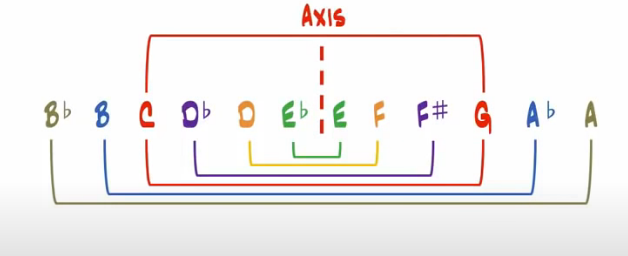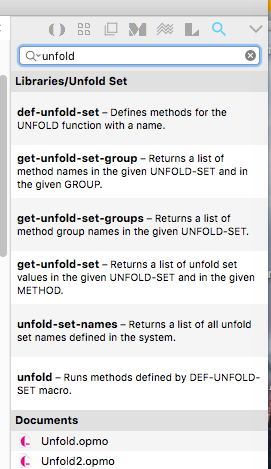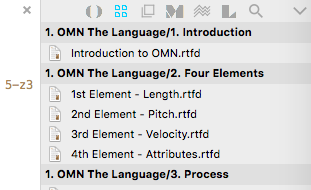-
Posts
814 -
Joined
-
Last visited
Content Type
Forums
Events
Store
Video Gallery
Everything posted by JulioHerrlein
-
WHY I USE OPUSMODUS SOFTWARE IN MY MUSICAL COMPOSITION PROCESS In this video I will describe some of the techniques I used in my compositional process and why I decided to use OPUSMODUS Software for compose music ! Also my experience with Pure Data and Nodal Software before moving to Opusmodus.
-
I just realized that would be great to have snippet audition and notation (Command+1) with the notation opening in separate window, like we have Evaluate and Audition and Notation - Window and in PS. Maybe not very difficult to implement, but great to have, to show to sutudents the gradual process of the compositional process, etc. Best, Julio
-
Dear Tom, Looks great ! Sometimes we find excellent stuff just by accident. I love when this happens ! Actually, as I said before, the negative harmony is sligthly different from just the inversion of the pitch. In your inversion, the pitch axis is the first note a4, so all the inversion operation is based in that first note. In the negative harmony, the axis lies between two notes and have some tonal orientation, i.e., it´s a kind of mapping that changes according to each tonality. For example, the mapping corresponding to the C center would be like: So, the "negative version" of your melody below: a4 g4 fs4 a4 d5 a4 fs5 d5 a5 fs5 e5 d5 would be, according to the graph above: Bb C Db Bb F Bb Db F Bb Db Eb F. Please, check the first video of the post, it´s very pedagogical. Probably Stephane will have a solution. The keyword is MAPPING. Maybe pattern substitution, pattern match, but a function where the octaves are relatives. All the best ! Julio
-

Session 6 - 20.06.20 - From Nothing (Part 2)
JulioHerrlein replied to Stephane Boussuge's topic in Zoom into Opusmodus
Thank you, Stephane ! Very nice presentation ! Best, Julio -
Thank you, Jorvd ! Best ! Julio
-
Dear All, I´m creating some permutations and I´d like to assign a text under each note to make clear the use of certain intervals. substitute-map '(T 2M 3M 4J 5J 6M 7M) '(c3 d3 e3 f3 g3 a3 b3) '(c3 d3 e3 f3 g3 c3 c3 c3 g3 c3 c3 d3)) But in the evaluation, I get this: (t 2m 3m 4j 5j t t t 5j t t 2m) With lowercase letters, I get 2m , 3m and 5J instead of 2M, 3M and 5J (uppercase names of intervals). Since I want it for pedagogical reasons, can it be generated with the corresponding UPPERCASE letters ? Thanks in advance. All the best, Julio
-
Thank you. Best !
- 5 replies
-
- omn
- articulation
-
(and 4 more)
Tagged with:
-
Thank you ! I went throughout docs, but it´s not clear enough to me. I understand that using the function "add-text-attributes" I can specify a new OMN expression attached to the notation. This is clear. But, please, I need more explanation on how to use it as a keyswitch, and how are the settings to make this text attribute trigger the keyswitches of my VLS library, (or any other). Please, can you provide some example ? Do I have also change/edit the Def-Sound_sets inside lisp files inside Def-Libraries (maybe the :omn section of these files, providing the new articulation information) ? Thanks in advance. Best, Julio
- 5 replies
-
- omn
- articulation
-
(and 4 more)
Tagged with:
-
Dear Friends, In a previous post (link below) there is a great description on how to configure old vsl gig versions. There is a place where you can configure the relation between the OMN articulation command with the correspondent keyswitch. QUESTIONS: 1) Let´s say I invent a new articulation in a custom sample library, for example "nail-scrape" for indicating the violin player to scrape the string with his/her nail. In this case, I need this OMN expression to: a) apear in the score notation and b) change the corresponding keyswitch. 2) In the case of the OMN expression "long", I configured it to change to the crescendo/diminuendo long samples in VSL, but this does not appear in the notation. This is great, because I don´t need it to be specified in the notation, since the long note values are enough, I just need the keyswitch. So there is the two scenarios: 1) CASE 1: OMN change keyswitch AND appear on the score 1) CASE 1: OMN change keyswitch AND DO NOT appear on the score The articulation expression syntax is a kind of yellow/brown word in the OMN code. Only articulation related words appear as an assignable articulation for this kind of use. FINALLY, THE GREAT QUESTION: How can I create my CUSTOM articulation OMN expression, like the "nail-scrape" example, so that this articulation can be customized also as appearing or not appearing in the score ? This can be really useful for expanded techniques in special scores with special sample libraries or even with scores based on customized samples, or new instruments. All the best ! Julio Herrlein :group omn stacc (:key c1 :key c1 cc1 40) stacs (:key c1 :key c1 cc1 25) ord (:key eb1 cc1 5) portato (:key cs1 cc1 5) sfz (:key e1 :key e1 cc1 25) cres (:key f1 :key f1 cc1 25) marc (:key e1 cc1 64) spicc (:key c1 cc1 120) leg (:key d1 :key d1 cc1 40) tasto (:key cs2 :key cs1 cc1 40) leg+tasto (:key cs2 :key cs1 cc1 40) tasto+leg (:key cs2 :key cs1 cc1 40)
- 5 replies
-
- omn
- articulation
-
(and 4 more)
Tagged with:
-

Combination without repeating elements
JulioHerrlein replied to JulioHerrlein's topic in Function Examples
Thanks, Stephane ! It works great with combination, instead of combination 2. Best ! Julio -

Combination without repeating elements
JulioHerrlein replied to JulioHerrlein's topic in Function Examples
Thank you ! I will try it ! Best, Julio -
Dear Friends, I´m interested in the 4-note combinations of the diatonic scale without repeating elements. (combination2 4 '(c3 d3 e3 f3 g3 a3 b3)) The filter-repeat and the remove-duplicates are not giving the right result. PARTIAL RESULT,,, combination2, size: 4 ((b3 b3 b3 b3) (a3 b3 b3 b3) (g3 b3 b3 b3) (f3 b3 b3 b3) (e3 b3 b3 b3) (d3 b3 b3 b3) (c3 b3 b3 b3) (b3 a3 b3 b3) (a3 a3 b3 b3) (g3 a3 b3 b3) (f3 a3 b3 b3) (e3 a3 b3 b3) (d3 a3 b3 b3) (c3 a3 b3 b3) (b3 g3 b3 b3) (a3 g3 b3 b3) (g3 g3 b3 b3) (f3 g3 b3 b3) (e3 g3 b3 b3) (d3 g3 b3 b3) (c3 g3 b3 b3) (b3 f3 b3 b3) (a3 f3 b3 b3) (g3 f3 b3 b3) (f3 f3 b3 b3) (e3 f3 b3 b3) (d3 f3 b3 b3) (c3 f3 b3 b3) (b3 e3 b3 b3) (a3 e3 b3 b3) (g3 e3 b3 b3) (f3 e3 b3 b3) (e3 e3 b3 b3) (d3 e3 b3 b3) (c3 e3 b3 b3) (b3 d3 b3 b3) (a3 d3 b3 b3) (g3 d3 b3 b3) (f3 d3 b3 b3) (e3 d3 b3 b3) (d3 d3 b3 b3) (c3 d3 b3 b3) (b3 c3 b3 b3) (a3 c3 b3 b3) (g3 c3 b3 b3) (f3 c3 b3 b3) (e3 c3 b3 b3) (d3 c3 b3 b3) (c3 c3 b3 b3) (b3 b3 a3 b3) (a3 b3 a3 b3) (g3 b3 a3 b3) (f3 b3 a3 b3) (e3 b3 a3 b3) (d3 b3 a3 b3) (c3 b3 a3 b3) (b3 a3 a3 b3) (a3 a3 a3 b3) (g3 a3 a3 b3) (f3 a3 a3 b3) (e3 a3 a3 b3) (d3 a3 a3 b3) (c3 a3 a3 b3) (b3 g3 a3 b3) (a3 g3 a3 b3) (g3 g3 a3 b3) (f3 g3 a3 b3) (e3 g3 a3 b3) (d3 g3 a3 b3) (c3 g3 a3 b3) (b3 f3 a3 b3) (a3 f3 a3 b3) I want to filter OUT the sets like ((b3 b3 b3 b3) (a3 b3 b3 b3) (g3 b3 b3 b3) (f3 b3 b3 b3) (e3 b3 b3 b3) (d3 b3 b3 b3) With one or more repeating notes. Best, Julio
-

audio Couleurs du temps présent pour Flute et Piano
JulioHerrlein replied to Stephane Boussuge's topic in Made In Opusmodus
Very nice ! Some Messiaen touch. -

Giant Steps Improvisation generator
JulioHerrlein replied to JulioHerrlein's topic in Score and Notation
Thanks a lot, Janusz !! Julio- 8 replies
-
- harmonic path
- coltrane
-
(and 2 more)
Tagged with:
-

Giant Steps Improvisation generator
JulioHerrlein replied to JulioHerrlein's topic in Score and Notation
Thanks for editing the file, Janusz ! Here is some Giant Steps in 12 keys ! Best ! Julio- 8 replies
-
- harmonic path
- coltrane
-
(and 2 more)
Tagged with:
-

Giant Steps Improvisation generator
JulioHerrlein replied to JulioHerrlein's topic in Score and Notation
Thank you, Ole ! Yes, the function changed. Here is some discussion about it. Best, Julio- 8 replies
-
- harmonic path
- coltrane
-
(and 2 more)
Tagged with:
-
Here are some ideas using a jazz standard progression: Best, Julio
-

Generate gestures through midi input
JulioHerrlein replied to Hencleeday's topic in Score and Notation
One of the most interesting features of Opusmodus is the Unfold function. Within this function you can define many ways to vary your starting material. Of course you will have to learn what each function can do, like pitch transpose, length, etc. But once you figure it out there are many possibilities. The DEF-UNFOLD-SET and UNFOLD function opens up a whole new set of possibilities for the composer using OPUSMODUS. It can prove a very powerful tool in defining methods (functions) from the outset, for a specific work or as a global index of your most used functions. To be able to store methods, processes and solutions and call them at anytime becomes a valuable resource for a composers workflow. This function is a companion to the DEF-UNFOLD-SET function. -
-
Hello, Please, take a look on this: Best ! Julio
-
Thank you, Janusz ! Great ! Julio
-
A more specific example (pcs-super-sets 4 (pcs '3-1) :forte) ;; (4-1 4-2 4-2b 4-4 4-4b 4-5 4-5b 4-6) (pcs-super-sets 4 (pcs '3-1) :forte :complementary) ;; (all other 4 note sets, except 4-1 4-2 4-2b 4-4 4-4b 4-5 4-5b 4-6) Best, Julio
-
Dear All, Happy New Year I´m back to a lot of work with sets, subsets and supersets and I have an idea/suggestion: When evaluating this (pcs-super-sets 7 (pcs '3-1) :forte) I get this result (7-1 7-2 7-2b 7-3 7-3b 7-4 7-4b 7-5 7-5b 7-6 7-6b 7-7 7-7b 7-8 7-9 7-9b 7-10 7-10b 7-11 7-11b 7-z12 7-13 7-13b 7-14 7-14b 7-15 7-16 7-16b 7-z17 7-z18 7-z18b 7-19 7-19b 7-20 7-20b 7-21 7-21b 7-22 7-23 7-23b 7-24 7-24b 7-25 7-25b 7-26 7-26b 7-27 7-27b 7-28 7-28b 7-29 7-29b 7-30 7-30b 7-33 7-z36 7-z36b 7-z37 7-z38 7-z38b) These are all the supersets of cardinality 7 of the 3-1 set. Would be very nice in this context to have a keyword to invert the result, i.e., actually showing the excluded sets, like all the sets that ARE NOT supersets of the 3-1 set. Like inverting, like a (pcs-non-super-sets) function. I think that maybe it´s not so difficult, because the algorythm of the function already give the result, the only thing necessary is that the function return exactly the opposite result. Best, Julio
-

solved [SOLVED] Idea for a Rhythmic Set Theory Function
JulioHerrlein replied to JulioHerrlein's topic in Function Examples
Dear Janusz, Thanks a lot ! This is great ! Exactly like my dissertation concept, expressed in thius great function ! This rocks ! All the Best. A very happy 2020 to you all ! Julio- 40 replies
-
- pitches-rhythm isomorphism
- toussaint
- (and 6 more)





